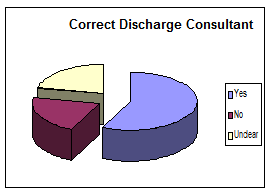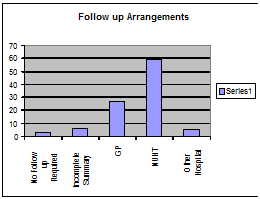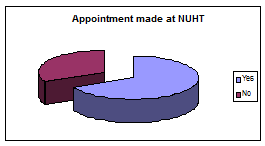Quality of Electronic Discharge Summaries at Newham University Hospital: An Audit
Syeda M B Kazmi
Cite this article as: BJMP 2008:1(1) 30-32
|
Syeda M. B. Kazmi
INTRODUCTION
The effectiveness and quality of care for patients is largely dependent on communication between physicians both in secondary care and in primary care. Written communication between secondary and primary care in the form of a discharge summary is vitally important for informing General Practitioners (GPs) and other healthcare professionals of the details regarding patients’ admission into hospital, as well as ensuring there is continuity of care in the community. Discharge summaries are often the only form of communication that occurs at the transition between secondary and primary care.
Prior to discharging patients from hospital, a discharge summary (whether this be hand written or typed) is required to be completed. Ideally copies are kept in patient files and given to the patient, as well as forwarding a copy to the GP. Correctly completing all relevant sections on a discharge summary is part of good medical practice, Clinical Governance and hospital/patient documentation.
Historically, discharge summaries have been found to be poorly written, contain inaccurate and ineffective information. Several studies have identified areas which are lacking in discharge summaries when looking at the quality of the discharge summary. These include: inadequacies of medical evaluation, level of experience of the discharge author and accuracy. Subsequently, there has been a general move towards electronic discharge summaries with a standard format.
In April 2005, Newham University Hospital Trust (NUHT) began using the Cerner Millennium Electronic Patient Record (EPR) system. This electronically stores information about a patient, for example discharge summaries, previous blood results, imaging results etc. It is intended that all discharge summaries are typed directly onto this computerized system. The summaries are then available to view by all authorized parties anywhere in the hospital. This system has the advantage of enabling access to portions of a patient’s medical record whilst waiting for patients’ old notes. Furthermore, more information can be added to the discharge summaries contemporaneously or even after the point of discharge. Table 1. Shows some advantages and disadvantages of EPR vs paper discharge summaries.
|
Disadvantages of EPR
|
AIMS AND OBJECTIVES
This study assessed the quality of discharge summaries completed by medical specialties at Newham University Hospital Trust using the EPR system. The aim was to identify any problems and where they are occurring. The information gained would help in addressing any problems identified, to improve the quality of discharge summaries.
METHODS
I had an in-depth discussion with my supervisor about the feasibility, methodology, data collection, patient confidentiality, ethics and relevance of this audit to the Hospital.
I undertook a thorough literature search in Medline and other internet searches, reviewed the Journals in NUHT Library for similar audits which looked at the quality of discharge summaries.
A sample of 100 Medical (respiratory, endocrine and gastroenterology) and Care of the Elderly (CoE) discharge summaries of patients from NUHT were retrospectively audited. The hospital Audit Department provided me with the names of the last 100 patients who had been discharged from Medicine and CoE during October 2007. These were sequential discharges, not selected at random. We did not analyze any patients from the specialties of Surgery, Gynaecology, Paediatrics, Cardiology or Emergency Medicine.
After obtaining the names, the discharge summaries were analysed and information was collected on the following fields:
-
Name of Consultant on the discharge summary sheet
-
Which team the consultant belonged to: Medical, CoE or A&E
-
If the discharge consultant was correct
-
If date of admission had been completed
-
If date of discharge had been completed
-
If the patient was given a diagnosis
-
If a follow up appointment was suggested and what type of follow up this was (GP or NUHT or another hospital)
-
If a follow up appointment had been made
-
If the discharge summaries had been signed and bleep number provided
This data was then tabulated using simple statistical analysis (mainly descriptive) and the results calculated into a percentage.
The names of the consultants on the discharge summaries were divided into Medical, Care of the Elderly and Accident & Emergency. The medical team was further divided into team A, B and C, according to the specialty they worked under, for example Team A: endocrine, team B: gastroenterology, and team C: respiratory medicine. By dividing the consultants under different teams allowed me to confirm if they were the right consultant. A&E was included into this field as many discharges still have A&E consultants on them despite the patients being admitted to hospital.
This audit did not address the following issues:
1. If the GP is correct
2. If the GP received the summary
3. If the GP made follow up arrangements post discharge
4. The accuracy of the diagnosis
5. If the patient has more than one electronic medical records
RESULTS
The examination of 100 medical records yielded 94 discharge summaries available for audit, leaving 6 medical records with no evidence of a discharge summary.
As mentioned above, the consultants on the discharge summary were divided into the following categories. The number beside them represents how many discharge summaries belonged to each respective team.
-
Care of the elderly team: 46
-
Adult medicine: 36
-
A&E: 9
-
Other: 3
It was found that 57(60.6%) of the discharge summaries contained the correct consultant name. However, on 22(23.4%) of the discharge summaries it was unclear if the discharge consultant was correct.

From the 96 discharge summaries completed, every single summary had an admission date on it, however, only 75(79.8%) of discharge summaries had a discharge date.
Seventy five (79.8%) of discharge summaries had been signed by the author (with their name), but only 71(75.5%) had wrote their bleep number.
Sixty five (69.1%) summaries were identified to have a diagnoses under the heading of acute problems, whereas only 22(23.4%) had only symptoms. The remaining 13 (13.8%) summaries had no diagnosis or symptoms completed.
Finally, when analyzing the discharge summaries regarding follow up arrangements, 91(96.8%) discharge summaries had a follow up suggested, of which 27(29.7%) were to be followed up by GP, 59(64.8%) were to be followed in NUHT and 5 patients were to be followed up at another hospital.

Of the discharge summaries which had follow up arranged in NUHT, only 40(67.8%) patients had a follow up appointment made.

DISCUSSION
This study supports previous studies, confirming that a new approach to discharge summary completion is required. One of the main problems identified in this summary, was the use of incorrect consultants on the discharge summary. The current method used is clearly not effective; therefore it is important that the author completing the discharge summary ensures that the correct consultant is on the summary.
Changing the Consultant name on the discharge summaries is of great importance because this means that GPs are able to refer patients back to the correct consultants when seeking advice or trying to arrange further follow up with that consultant. Furthermore, it allows the appropriate National Health Service (NHS) funding to be given to the relevant department.
It was unclear in 22 discharge summaries if the discharge Consultant was correct. This was partly due to the fact that several discharge summaries had no author name or bleep number. By documenting your name and bleep number on a discharge summary, is not only accessible to physicians in primary and secondary care, but also to hospital pharmacist, in case they need to contact you when medication needs to be amended.
The second important problem identified in this study, was the lack of follow up appointments made, despite having it requested on the discharge summary. Of the patients that had follow up appointments suggested at NUHT, only 40(67.8%) patients had follow appointments made, which meant that 19(32.2%) patients had no appointment made. The only possible explanations for this may be that I started analyzing the patient summaries and follow up appointments too early post discharged, therefore not allowing enough time for the appointments to be made, or perhaps the appointments are simply not being made.
As this study did not look to see whether follow appointments with GPs had been made, we are unable to comment on this. However, previous studies have shown that follow up appointments are not always made with the GPs post discharge. As a result, the percentage of patients actually receiving a follow up post discharge from hospital may be lower than anticipated.
The third problem this study identified was the lack of discharge dates on the summaries. Having the discharge date on discharge summaries is not only important for hospital doctors but its of vital importance for GPs, as it provides them with information about how long a patient remained in hospital, and the severity of their illness. For example, if a patient was discharged from hospital after 2 days with an Asthma Exacerbation, we can assume that the severity of their exacerbation was not too severe. However, if the same pt remains in hospital for 15 days, this gives us more information about the severity of their exacerbation.
The fourth problem demonstrated in this study, was the infrequent number of diagnoses entered under the acute problems section in the discharge summaries. Only 65 (69.1%) summaries were identified to have a diagnoses, 22(23.4%) summaries had symptoms only. The remaining 13 (13.8%) summaries had no diagnosis or symptoms completed. It is important to document diagnosis or symptoms as it allows accurate medical coding. It is also often difficult to fathom why a patient was admitted to hospital even after reading the entire discharge summary. Furthermore, the benefit of accurate clinical coding is accurate payment for the services provided by the hospital.
The final problem which needs to be addressed is the completion of a discharge summary for all patients that have been admitted to hospital. This study found that 6 medical records showed no evidence of a discharge summary. One possible explanation for this would be if a patient had self discharged from the hospital, and not been formally discharged by a team or if a patient had died. However, in this case it is still important that a discharge summary is completed. A GP will still need to know why a patient was admitted and why they self discharged
CONCLUSION
It is clear from this study that there needs to be more robust processes put in place to ensure accurate recording of data on the information sent out to General Practitioners. Medical Practitioners completing the summaries should be encouraged to ensure that all fields on the discharge summary are adequately completed in order for us to reap the benefits.
Poor communication in the discharge summaries impacts poorly on patient care and increases the costs to the NHS due to increased rates of readmission into hospital. We can recognize this as a major problem confronting the NHS and so completing discharge summaries in full can help reduce his burden.
RECOMMENDATIONS
A number of recommendations have been identified and include:
-
The need to raise the awareness of this problem amongst hospital colleagues including Clinical Governance and Audit department with the objective to improve the quality of the summary. The preferred format may be a presentation or advisory email.
-
For consultants to communicate with junior doctors on a regular basis and go through their discharge summaries, highlighting areas of improvement. This is currently done by some medical teams at NUHT.
-
For the author of the discharge summary to ensure the correct consultant name is on the discharge summary.
-
All medical teams should complete a discharge summary regardless if a patient has self discharged or died.
-
To relay this information back to the ward clerks and ensure that they understand the importance of making follow up appointments as soon as they have been given a discharge summary.
-
A repeat audit should be performed in 12 months to look for improvements in the data completion.
CONFLICT OF INTERESTS
None declared
ACKNOWLEDGMENTS
The author would like to thank Dr T. O’Shaughnessy, Medical Student Umair Mohammed, Dr David Ward, and the Audit Department for all their help and support
AUTHOR DETAILS
SYEDA M. B. KAZMI, Foundation Year 2 Trainee, Barts and The London School of Medicine and Dentistry, Queen Mary University of London, London, United Kingdom
CORRESPONDENCE: DR S M B Kazmi, 15 Kevelioc Road, Tottenham, London, N17 7PR
Email: mar1amkazmi@hotmail.com
REFERENCES
-
Mann R and Williams J. Standards in medical record keeping. Clinical medicine. 2003 jul-Aug; 3 (4): 329-32
-
Paterson JM, Allega RL. Improving communication between hospital and community physicians. Feasibility study of a handwritten, faxed hospital discharge summary. Discharge Summary Study Group. Can Fam Physicians. 1999 Dec; 45: 2893-9
-
Wilson S, Ruscoe W, Chapman M, Miller R. General practitioner –hospital communications: a review of discharge summaries. Journal of Quality in Clinical Practice. 2001 Dec; 21(4): 104-8
-
Foster DS, Paterson C, Fairfield G. Evaluation of immediate discharge documents–room for improvement? Scott Med J. 2002 Aug; 47(4): 77-9
-
Garasen H and Johnsen R. The quality of communication about older patients between hospital physicians and general practitioners: a panel study assessment. BMC Health Services Research. 2007 Aug24; 7: 133

The above article is licensed under a Creative Commons Attribution-NonCommercial-NoDerivatives 4.0 International License.




